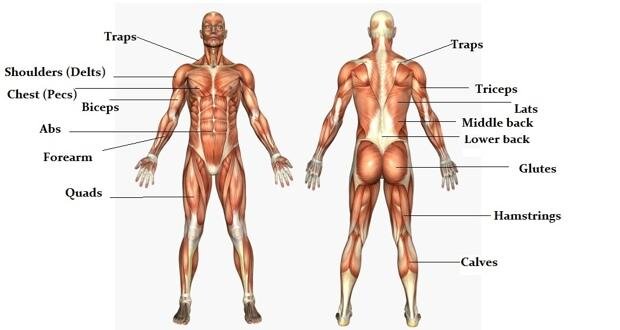Know Your Muscles
Whether you’re training for weight loss, toning, or general health & wellness, you MUST include resistance training in your weekly exercise routine.
To make the most of your resistance training, you need to know the basics of what the major muscle groups are and what they do.
Muscles in the body Picture Credit: The Health Site
Begin to make the connection between to muscles are being used and learn to name them. This will help you to make sure you're practicing the exercises correctly.
Lower Body Muscles:
Quadriceps: The Quadriceps muscles run along the front of your thighs and are responsible for knee extension (straightening out your leg). Squats and Step Ups are great exercises for strengthening this muscle group.
Hamstrings: The Hamstrings are the muscles on the back of your thighs, and are responsible for knee flexion (being your knee). Squats and Step Ups are good for strengthening the Hamstrings.
Calves: The Calves muscles (soleus and gastrocnemius) run along the back of your leg from your ankle to your knee. They allow you to point your foot (plantar flexion). Step Ups and Calf Raises are great for strengthening the Calves.
Glutes: The Glutes are an important group of muscles in your hips and bottom. The Gluteus Maximus runs along your bottom, and are responsible for keeping your body upright from the hips. They also bring your leg backwards. The Gluteus Medius and Minimus are located in the sides of your hips, and are responsible for lifting your leg to the side and rotating your leg from the hip. Many exercises use this muscle group, for example Squats, Step Ups, and Deadlifts.
Upper Body Muscles:
Pecs: The Pecs (or Pectoralis muscles) are your chest muscles. They bring your shoulders forward, and are worked during Planks, Pushups, and Chest Presses. For most people, this muscle group is tight from sitting at a desk or computer all day. It's important to stretch this muscle group for good posture in addition to strength training (we'll cover Mobility training towards the end of the week).
Lats: The Lats (or Latissiumus Dorsi) muscles are the large muscles that run under your armpits and insert in the back. They activate to bring your arms close to your body. Lat Pull Downs, Lat Rows, and Pullovers are all great exercises for the Lats.
Deltoids: The Deltoids are your shoulder muscles that bring your arms up and out away from your body. These muscles assist during many upper body exercises like Planks, Pushups, and Chest Presses. You can strengthen them by performing Overhead Presses or Side Raises.
Biceps: The Biceps are the muscles running along the upper interior part of your arm. They are responsible for elbow flexion--bending the elbow. They assist during many exercises, such as the Lat Pull Downs and Lat Rows. You can focus on them with Biceps Curls.
Triceps: The Triceps muscles run along the back of your upper arm, and they activate for elbow extension (straightening out the elbow). they are helpers in exercises like Planks, Pushups, and chest Presses, and you can focus work on them with the Triceps Dips and Triceps Kickback Exercises.
Core Muscles:
Abs: The Abs (or Abdominals) are the muscles that run along the front of your torso and connect your ribs to your hips from the front. They are the muscles used when you perform a Crunch. They stabilize your core in nearly all exercises--so it's important to keep them strong!
Obliques: Your Obliques muscles run along the sides of your torso and help you to twist and bend sideways at the waist. Like the Abdominals, your Obliques are an important stabilizing muscle group that activates in almost all compound exercises. Strengthen them with exercises like Russian Twists, Reclined Knee Drops, Bicycle Crunches, & Standing Side Bends.
Erector Spinae: Your Erector Spinae muscles run alongside your spine and are responsible for keeping your body upright and spine straight. They are important for good posture and help keep good form in many exercises. Strengthen the Erector Spinae muscles with Supermans and Bridges.
Try to develop an awareness of which muscle groups are firing while you perform your resistance training exercises. When you perform a set, ask yourself Where did I feel the work? Point to the muscles you felt working and try to name them.
Knowing which muscles you should be feeling and noticing when they are working or not working will help you to perform the exercises with proper form. It will also help you in the future when you learn new exercises.
Sign Up for Personal Training!
If you’d like additional guidance on training, submit a consultation form and I’ll help you create a plan of action to reach your goals. I offer online, one-on-one, and semi-private personal training and health coaching to individuals, couples, and groups. Click on the button below to get started.
About the Author
Jayd Harrison is a personal trainer and content creator. She helps people to build muscle, burn fat, and clean up their diets with her online coaching programs and social media content. Check out some of Jayd’s coaching videos on Youtube, or join Jayd live on Twitch and follow on social media.

